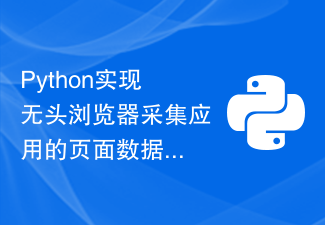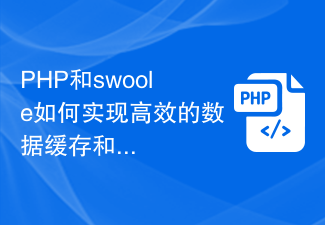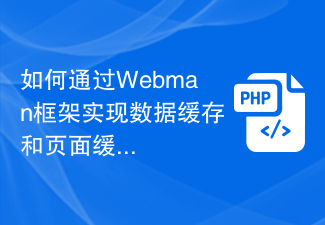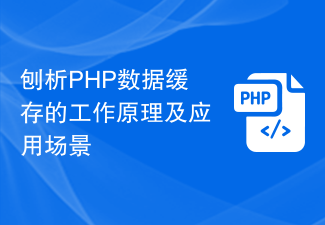 PHP Framework
PHP Framework Workerman
Workerman How to implement data caching and page caching through the Webman framework?
How to implement data caching and page caching through the Webman framework?How to implement data caching and page caching through the Webman framework?
Webman is a Python-based Web framework that is lightweight, flexible, easy to use, and supports a variety of plug-ins and extensions. In web development, implementing data caching and page caching is one of the important means to improve website performance and user experience. In this article, we will explore how to implement data caching and page caching through the Webman framework and give corresponding code examples.
1. Data caching
Data caching is to temporarily store some frequently accessed data in memory to reduce the number of accesses to the database or other external storage and improve the reading speed of data. The Webman framework provides a simple caching interface, which we can easily use to implement the data caching function.
Code example:
from webman import cache
# 定义一个缓存对象
data_cache = cache.Cache()
# 获取数据的函数
def get_data():
# 先从缓存中获取数据
data = data_cache.get('data')
if data is not None:
return data
# 如果缓存中没有数据,则从数据库中获取
data = query_data_from_db()
# 将数据存入缓存,并设置过期时间为10分钟
data_cache.set('data', data, timeout=600)
return dataIn the above code, we first create a cache object data_cache, and then define a get_data function to obtain data. In the function, we first try to get the data from the cache. If there is data in the cache, it returns directly; if there is no data in the cache, we get it from the database, store the obtained data in the cache, and set the expiration date. The time is 10 minutes.
2. Page caching
Page caching generates static HTML files for some frequently visited pages and stores them on the hard disk to reduce the cost of dynamically generating pages during subsequent visits. The Webman framework provides convenient page caching functionality, which we can easily apply to our web applications.
Code example:
from webman import cache
# 定义一个缓存对象
page_cache = cache.Cache()
# 缓存页面的装饰器
def cache_page(timeout=60):
def decorator(func):
def wrapper(*args, **kwargs):
# 构建缓存键值
cache_key = 'page:' + request.path + '?' + request.query_string
# 先从缓存中获取页面
page = page_cache.get(cache_key)
if page is not None:
return page
# 如果缓存中没有页面,则生成动态页面
html = func(*args, **kwargs)
# 将页面存入缓存,并设置过期时间
page_cache.set(cache_key, html, timeout=timeout)
return html
return wrapper
return decorator
# 使用页面缓存的函数
@cache_page(timeout=300)
def home_page():
return render_template('home.html')In the above code, we first create a cache object page_cache and define a decorator cache_page for caching the page. Inside the decorator, we first build a cache key based on the requested path and query string, and then try to get the page from the cache. If there is a page in the cache, it returns directly; if there is no page in the cache, the original The function generates a dynamic page, stores the generated page in the cache, and sets the expiration time. Finally, we use the decorator to decorate the home_page function to implement the page cache function.
Summary:
Through the caching interface and page caching function provided by the Webman framework, we can easily implement data caching and page caching to improve the performance and user experience of Web applications. In actual applications, we can choose appropriate caching strategies based on specific needs and scenarios, and combine them with other optimization measures to further improve the performance of our web applications.
The above is the detailed content of How to implement data caching and page caching through the Webman framework?. For more information, please follow other related articles on the PHP Chinese website!
 Python实现无头浏览器采集应用的页面数据缓存与增量更新功能剖析Aug 08, 2023 am 08:28 AM
Python实现无头浏览器采集应用的页面数据缓存与增量更新功能剖析Aug 08, 2023 am 08:28 AMPython实现无头浏览器采集应用的页面数据缓存与增量更新功能剖析导语:随着网络应用的不断普及,许多数据采集任务需要对网页进行抓取和解析。而无头浏览器通过模拟浏览器的行为,可以实现对网页的完全操作,使得页面数据的采集变得简单高效。本文将介绍使用Python实现无头浏览器采集应用的页面数据缓存与增量更新功能的具体实现方法,并附上详细的代码示例。一、基本原理无头
 PHP和swoole如何实现高效的数据缓存和存储?Jul 23, 2023 pm 04:03 PM
PHP和swoole如何实现高效的数据缓存和存储?Jul 23, 2023 pm 04:03 PMPHP和swoole如何实现高效的数据缓存和存储?概述:在Web应用开发中,数据的缓存和存储是非常重要的一部分。而PHP和swoole提供了一种高效的方法来实现数据的缓存与存储。本文将介绍如何使用PHP和swoole来实现高效的数据缓存和存储,并给出相应的代码示例。一、swoole简介:swoole是一个针对PHP语言开发的,高性能的异步网络通信引擎,它可以
 Golang中数据缓存、结果缓存、页面缓存都应当怎样使用?Jun 19, 2023 pm 09:04 PM
Golang中数据缓存、结果缓存、页面缓存都应当怎样使用?Jun 19, 2023 pm 09:04 PMGolang是一门高效、简洁、可靠的编程语言,其在Web应用程序方面的使用越来越广泛。为了优化Web应用程序的性能,开发人员通常需要使用缓存技术来减少资源的访问和提升应用程序的响应速度。在Golang中,数据缓存、结果缓存和页面缓存是常用的缓存技术。在本文中,我们将了解这3个缓存技术的用途和用法。1.数据缓存数据缓存是指将经常访问的数据存储到内存中,以提高
 如何使用PHP和SQLite进行数据缓存和优化Jul 30, 2023 am 11:57 AM
如何使用PHP和SQLite进行数据缓存和优化Jul 30, 2023 am 11:57 AM如何使用PHP和SQLite进行数据缓存和优化引言:在开发Web应用程序的过程中,数据缓存和优化对于提高性能和减少数据库查询次数非常重要。PHP提供了丰富的数据库操作功能,而SQLite则是一种轻量级的嵌入式数据库,非常适合用于缓存数据。本文将介绍如何使用PHP和SQLite进行数据缓存和优化。一、什么是SQLiteSQLite是一种嵌入式的关系型数
 小程序开发中的PHP数据缓存与缓存策略Jul 05, 2023 pm 02:57 PM
小程序开发中的PHP数据缓存与缓存策略Jul 05, 2023 pm 02:57 PM小程序开发中的PHP数据缓存与缓存策略随着小程序的快速发展,更多的开发者开始关注如何提高小程序的性能和响应速度。其中一个重要的优化手段就是使用数据缓存来减少对数据库和外部接口的频繁访问。而在PHP中,我们可以利用各种缓存策略来实现数据缓存。本文将介绍PHP中的数据缓存原理,并提供几个常见的缓存策略的示例代码。一、数据缓存原理数据缓存是指将数据存放在内存中,以
 UniApp实现数据缓存与持久化存储的最佳方案Jul 05, 2023 pm 08:33 PM
UniApp实现数据缓存与持久化存储的最佳方案Jul 05, 2023 pm 08:33 PMUniApp是一种基于Vue.js的跨平台开发框架,可以将一个项目同时编译成多个平台上可运行的应用程序,如iOS、Android等。在开发移动应用时,数据的缓存和持久化存储是非常重要的方面,本文将介绍UniApp中实现数据缓存与持久化存储的最佳方案,并提供相应的代码示例。一、数据缓存在移动应用开发中,为了提高应用的用户体验,减少网络请求的次数和数据加载的时间
 如何通过Webman框架实现数据缓存和页面缓存?Jul 08, 2023 am 10:58 AM
如何通过Webman框架实现数据缓存和页面缓存?Jul 08, 2023 am 10:58 AM如何通过Webman框架实现数据缓存和页面缓存?Webman是一款基于Python的Web框架,它具有轻量、灵活、易用的特点,并且支持多种插件和扩展。在Web开发中,实现数据缓存和页面缓存是提高网站性能和用户体验的重要手段之一。在本文中,我们将探讨如何通过Webman框架实现数据缓存和页面缓存,并给出相应的代码示例。一、数据缓存数据缓存是将一些频繁访问的数据
 刨析PHP数据缓存的工作原理及应用场景Aug 10, 2023 am 09:41 AM
刨析PHP数据缓存的工作原理及应用场景Aug 10, 2023 am 09:41 AM刨析PHP数据缓存的工作原理及应用场景随着互联网技术的不断发展,用户访问量的大幅增加,对于数据的处理能力和效率要求也越来越高。在PHP开发中,数据缓存技术被广泛应用,可以有效地提高网站性能和用户体验。本文通过分析PHP数据缓存的工作原理,结合实际应用场景,来深入了解如何使用数据缓存提升网站性能。一、PHP数据缓存的工作原理PHP数据缓存是将一些经常使用的数据


Hot AI Tools

Undresser.AI Undress
AI-powered app for creating realistic nude photos

AI Clothes Remover
Online AI tool for removing clothes from photos.

Undress AI Tool
Undress images for free

Clothoff.io
AI clothes remover

AI Hentai Generator
Generate AI Hentai for free.

Hot Article

Hot Tools

Dreamweaver Mac version
Visual web development tools

SAP NetWeaver Server Adapter for Eclipse
Integrate Eclipse with SAP NetWeaver application server.

Atom editor mac version download
The most popular open source editor

VSCode Windows 64-bit Download
A free and powerful IDE editor launched by Microsoft

SublimeText3 Chinese version
Chinese version, very easy to use





